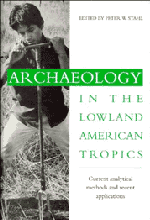Book contents
- Frontmatter
- Contents
- List of figures
- List of tables
- List of contributors
- Introduction
- 1 Archaeological survey and site discovery in the forested neotropics
- 2 The archaeology of community organization in the tropical lowlands: a case study from Puerto Rico
- 3 Archaeological methods for the study of ancient landscapes of the Llanos de Mojos in the Bolivian Amazon
- 4 Searching for environmental stress: climatic and anthropogenic influences on the landscape of Colombia
- 5 “Doing” paleoethnobotany in the tropical lowlands: adaptation and innovation in methodology
- 6 Plant microfossils and their application in the New World tropics
- 7 Differential preservation histories affecting the mammalian zooarchaeological record from the forested neotropical lowlands
- 8 Biological research with archaeologically recovered human remains from Ecuador: methodological issues
- 9 Interpreting dietary maize from bone stable isotopes in the American tropics: the state of the art
- 10 From potsherds to pots: a first step in constructing cultural context from tropical forest archaeology
- 11 Returning to Pueblo Viejo: history and archaeology of the Chachi (Ecuador)
- References
- Index
10 - From potsherds to pots: a first step in constructing cultural context from tropical forest archaeology
Published online by Cambridge University Press: 23 November 2009
- Frontmatter
- Contents
- List of figures
- List of tables
- List of contributors
- Introduction
- 1 Archaeological survey and site discovery in the forested neotropics
- 2 The archaeology of community organization in the tropical lowlands: a case study from Puerto Rico
- 3 Archaeological methods for the study of ancient landscapes of the Llanos de Mojos in the Bolivian Amazon
- 4 Searching for environmental stress: climatic and anthropogenic influences on the landscape of Colombia
- 5 “Doing” paleoethnobotany in the tropical lowlands: adaptation and innovation in methodology
- 6 Plant microfossils and their application in the New World tropics
- 7 Differential preservation histories affecting the mammalian zooarchaeological record from the forested neotropical lowlands
- 8 Biological research with archaeologically recovered human remains from Ecuador: methodological issues
- 9 Interpreting dietary maize from bone stable isotopes in the American tropics: the state of the art
- 10 From potsherds to pots: a first step in constructing cultural context from tropical forest archaeology
- 11 Returning to Pueblo Viejo: history and archaeology of the Chachi (Ecuador)
- References
- Index
Summary
In this chapter I do not intend to plow new ground, but take a retrospective stance through explicating a particular methodology which has been applied to the classification of pottery in the South American tropical lowlands. I shall refer to this methodology as structural classification, since it is modeled after the methodology of descriptive linguistics. It is not to be confused with structuralism or structuralist analysis (Leone 1982) as those terms are currently used in a Lévi-Straussian sense in the archaeological literature. It is more akin to what has been called componential analysis, or ethnoscience in anthropological literature of the past four decades. Donald Lathrap was a strong advocate of this methodology, and his unpublished thesis (Lathrap 1962) is the earliest example of a thorough application of this methodology to an archaeological data set.
I write this with a slight feeling of apprehension, knowing that classification, particularly as it applies to ceramics, has historically been a hotly debated subject among archaeologists. As Spaulding (1982: 1) astutely observed, “Basic concepts and their implications are often controversial simply because they are basic.” If I touch some raw nerves, it is not by intention. My objective is to elucidate a particular methodology which has been used and developed by archaeologists working in the South American tropics over the past three decades.
- Type
- Chapter
- Information
- Archaeology in the Lowland American TropicsCurrent Analytical Methods and Applications, pp. 224 - 242Publisher: Cambridge University PressPrint publication year: 1995
- 2
- Cited by

